Subtleties of the process of plastering the ceiling

An important element of creating warmth and comfort in any home is the ceiling. A beautiful chandelier is attached to it, emitting soft light. You can make the ceiling surface of an apartment or house exquisite, solemn, stylish using various construction techniques and finishing methods.

Peculiarities
With modern possibilities of choosing building materials repair of the ceiling surface can be done in different ways:
- it can be whitewashed;
- paint;
- make suspended;
- prepare for laying tiles;
- stick the wallpaper.





Each of these finishes, each with its own pros and cons, is preceded by processes such as priming and plastering.


First, preparatory work is carried out
In a newly built house or apartment with concrete ceilings, plastering begins with the preparation of the foundations. It is best to roughen the ceiling surface. To do this, a notch is applied along the entire perimeter with special tools or by an improvised method (using an ax).
After exposure in this way, jags remain on the surface of the ceiling., which in the future will allow the plaster to gain a foothold. After completing the priming work, you can start treating the surface with cement mortar. It is used to seal the ceiling of the floor slabs.


An important factor to be considered is indoor humidity (no more than 30%).
In case of non-observance of this parameter, as well as when applying cement plaster in a different temperature regime, there will be a possibility of its poor fixation.

When it comes to an apartment or house in which they lived for a long period of time, then, having started plastering work, it is necessary to dismantle the old surface (remove layers of paint, wallpaper and other materials). This process is more time consuming and labor intensive.

Lime can be moistened with water and then removed with a spatula. Old water-based paint, for example, is removed with a solution of iodine and water. A vial (bottle) of iodine composition is used for 1 bucket of water. If there was a fungus on the ceiling, then you can remove it by moistening the base with a composition of copper sulfate and water (5 grams of the mixture is used for 1 liter of water).
Whitewashed ceilings and covered with lime mortar are soaked with water, then remove the old layers with a spatula. After dismantling, the surfaces are thoroughly washed off with water and allowed to dry.


In a building with a wooden ceiling, work on plastering ceiling surfaces begins with preliminary stuffing of metal mesh or shingles (shingles) on it. These auxiliary materials will further help the applied layer of plaster to adhere tightly to the ceiling.
The ceiling, hemmed with gypsum plasterboards, must be cleaned of dirt. An important point is that there is no need to install beacons.

A primer is applied to the dried surface at the joints of the slabs (where the seams pass). Such points are processed most carefully.
The points where the sheets are interconnected (self-tapping screws, screws are screwed in) are tightened more tightly or use a special tape. All protruding parts are pasted over with it, then, in the process of puttying, the seams and irregularities are smoothed over.
After the primer layer has dried, the ceiling is putty, and thus it is prepared for painting or wallpapering.



Plastering drywall should be if its surface is very moisture resistant.
When the sheets do not differ in such a quality characteristic, then it is best not to carry out the plastering process.
If it is necessary to glue the plasterboard ceiling with thin wallpaper, it is possible to pre-plaster it. This is done so that the gypsum boards cannot be seen through the wallpaper.


How to plaster?
Before proceeding with the process of plastering the ceiling surface with your own hands, you must choose a primer and putty.
For different types of ceilings (concrete, wood, drywall), special mixtures and formulations of solutions for processing will be required.

Solutions for plastering ceilings and walls are used as follows:
- plaster;
- sand-cement composition;
- lime;
- silk plaster solution;
- a mixture of foam crumbs;
- decorative plaster;
- polymer mixture.
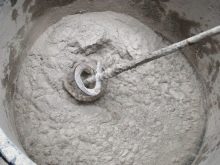





Mix selection
The modern construction industry offers a wide range of solutions and compositions for finishing ceilings.
Which one to choose for plastering in the best way, you can find out by familiarizing yourself with its quality characteristics. The finishing plaster is applied with different solutions depending on the ceiling base.
Gypsum composition can be used for plastering.

Its feature is the ability to tolerate mechanical damage well. The ceiling after processing with this mixture will not crack.
Polymer acrylic plaster is considered a versatile mixture. It is used for any reason. It is moisture resistant and durable.

Decorative plaster is divided into textured, embossed, flock, terrazzite, structural mixture.
All of them are compositions that create a three-dimensional appearance to ceiling surfaces:
- Structural plaster contains wood fibers.
- The relief composition contains synthetic fibers and particles of marble dust.


- The textured mortar consists of various additives and can have different compositions.
- Terrazite mixture is made on the basis of cement. Added to it are marble chips, mica and glass.
- Flocks are acrylic flakes of different sizes and colors. In combination with each other, they represent an extraordinary range of colors. After applying such a plaster, varnish is used as a finish.



Cement formulations include sand and lime additions. They are not classified as particularly durable, because over time, damage from mechanical stress is possible. There are also cracks in the ceiling.
Among the new mixtures often used in recent years, a special place is given to the new composition. The sand in the composition of the cement slurry was replaced by foam crumbs. A plastering solution is considered an insulating mixture. It also includes such components as pumice powder, foam granules, perlite sand.

Foam crumbs are non-toxic, absorb sound well and have high thermal insulation. The material is refractory and can withstand high minus and plus temperatures.
The ceiling is very well leveled with a solution filled with foam crumbs.


Silk plaster is composed of silk fibers. It also contains cellulose, glue and a number of additives that make the composition durable. These components make the filler porous, increasing sound insulation. Its qualities help to retain heat, which can escape through the cold ceiling.
The mixture must be diluted with water, the result is a creamy composition. It is precisely the type of its density that, when applied to the ceiling and walls, forms a layer that allows you to reliably hide defects and depressions. The result lives up to expectations. The surface is solid, without seams and joints.It is good to cover concrete bases with such plaster; after application, completely flat and smooth ceilings are obtained.


Tools for the job
Speaking about tools and devices for work, it should be noted that the putty is carried out using metal spatulas (different in width), a brush, and a roller.
You will need a plaster mixture, a container of water, a trowel, a drill with a nozzle or mixer, a sanding float, and glue.
It is advisable to use a protective mask and goggles to exclude the possibility of contact with the eyes and respiratory tract of layers of old materials to be dismantled. For drywall, you will need a primer and putty.


How to install beacons?
In order to correctly make the surface of the ceiling perfectly flat and beautiful after plastering, auxiliary materials are installed, called beacons (beacons). The very process of working with ceiling bases is laborious. Each centimeter of thickness is applied with an additional layer of mortar. By using beacons, this process can be reduced to a minimum.

They are attached to the ceiling base in such a way that the tops of these materials form a common very flat plane. Beacons are made using different materials. These can be wooden slats, metal profiles in the shape of the letter "T", strips of plaster mortar.
The most time-consuming of the three methods is creating plaster beacons.

Stripes are made along the ceiling, acting as guides. The entire base of the ceiling is then aligned along them.
The production of strips takes a rather long period of time, but the advantage of the work is that at the end of the work, such materials do not need to be removed from the ceiling and the places where they were attached are repaired.
A plus is the ability to make beacons of any height, since plaster is taken as a raw material for their manufacture.
T-shaped metal profiles are often used to apply plaster to a ceiling base up to 1 cm thick. If it is necessary to create a thicker layer, a solution is placed under the beacons, allowing in this way to reach the required height. It is easy to work with such profiles, however, when applying a thick layer to the ceiling, the process of setting the beacons to the same height takes a lot of time.

You can also level the ceiling with wooden slats. But the wood absorbs moisture in large volumes, so before work it is best to hold the slats in water, so that later, after drying, they do not change their size and thickness.
Convenient is their ease of attachment and use.
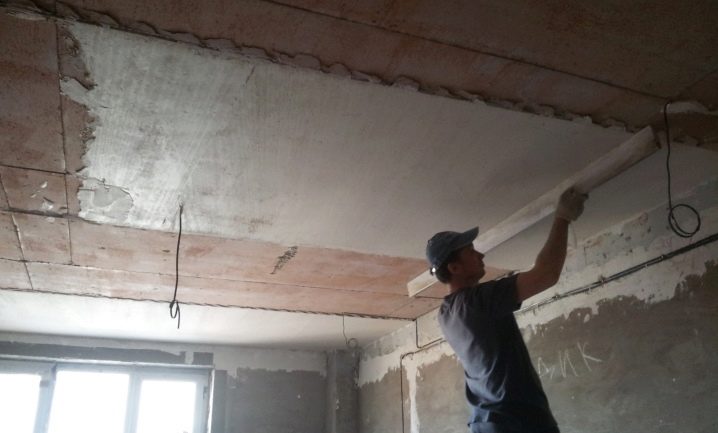
Any type of beacon chosen for installation on the ceiling in a bathroom, kitchen or living room is preceded by the process of marking it. The methods of installing beacons for the ceiling and walls are similar to each other.
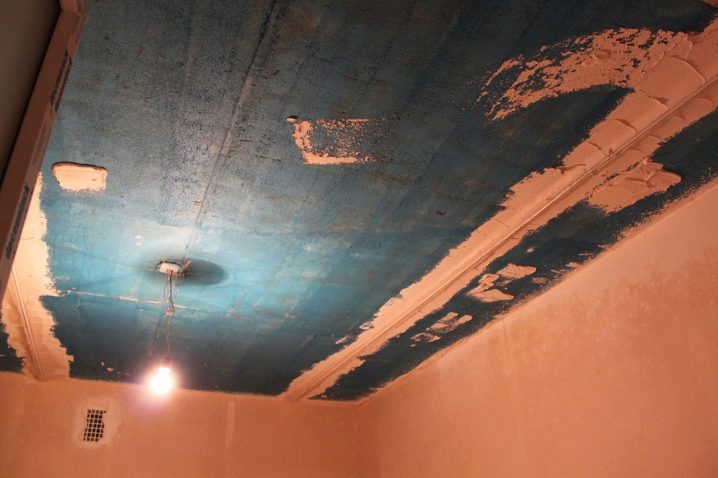
Step-by-step instructions for installing beacons
First, you need to check the ceiling surface with a level or chop thread. Determine the lowest point on the ceiling and mark (using a paint line). From this point, the installation of beacons begins.
Using masking tape, mark the ceiling on the line. Next, with a level (including a laser), the angles between the lines are checked so that they are strictly 90 degrees. After that, the rails (beacons) are attached to the guide lines with screws.



The distance between the rows of slats should be no more than 20 cm. The screws are leveled so that after work the ceiling base can cover all defects and problem areas (protrusions, depressions). Where there was the lowest point of the ceiling surface, the lighthouse is raised to the maximum height, thereby leveling it with other lighthouses around the entire perimeter. It is usually better to use a steel rail with a length of 60 cm to 1 m 40 cm.When plastering, it will move along the beacons throughout the entire ceiling area.
Preparation for further work ends here. Those interested can watch the video.
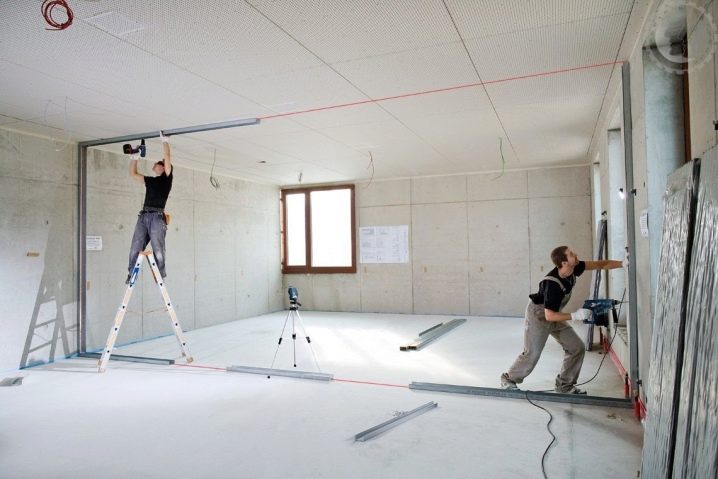
Plastering
Before plastering different ceilings, you must remember to prime any of them.
After the primer has dried, you can start installing the beacons and the plastering process. For different types of ceilings (wood, plasterboard, concrete), a special plaster mixture is used.
The technology of work is not particularly complex. Initially, a solution or putty is prepared.

To make the mixture very plastic, it is customary to add PVA glue to it. Applying such a solution to the ceiling will ensure its quick setting and strong fixation to the surface. Whatever the thickness of the plaster layer, such a solution will not allow the ceiling to crack or crumble in the future.
A mixture of water with PVA glue is made with a special mixer, gradually adding plaster to this liquid. Everything is mixed until a homogeneous mass is obtained.


The resulting solution with a spatula begins to be thrown onto the ceiling. The application is done in large bloopers, you need to ensure that they are next to each other. All voids and recesses are filled with a solution, and then they take a rule-rail and carry it along the lighthouses, like on rails.
It turns out a smooth canvas. In places where the plaster is superfluous, it is removed with a spatula.


In this way, a solution is thrown over it, and from above it is carried out with a rail like a ruler, leveling the ceiling surface. After the entire ceiling has been covered, the solution is given time to grab for about 30 - 40 minutes and then they again take the rail - as a rule, and cut off all the protrusions and irregularities over the entire area. At the same moment, the beacons are taken out, and the places where they were attached are smoothly sealed with mortar. When this stage of work is completed, the solution is given time to dry completely, and after that the plastered surface should be treated with water. After washing, it is rubbed (smoothed) with a spatula. This completes the work on plastering the ceiling surfaces.

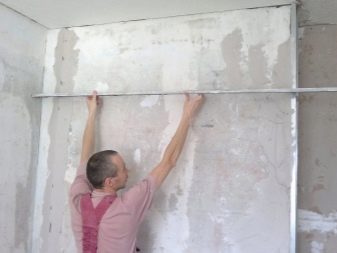
In the case of drywall (when it is plastered for painting), it is necessary to close up all the irregularities and apply a primer. The solution is also prepared using a mixer, carefully breaking up the lumps of plaster so that later they cannot cause irregularities on the surface of the ceiling.
Application is done with a spatula.

A solution is placed on it, then thrown onto the ceiling, evenly distributing. The solution layer should be thin. After the plaster on the ceiling has dried, the drywall must be sanded until it reaches a mirror-like surface.
Plasterboard sheets absorb decorative plaster very well. Plastering the surface of ceilings with stone materials has become a fashionable trend. They are grainy in structure.

As a result of application, beautiful convex surfaces are obtained. Dry stone chips are applied using a spray gun. It is best that the work on plastering ceilings be mechanized (machine) than manual.
Special machines for plastering work have appeared on the market for construction tools and accessories. With the manual method of work, the solution is prepared in small portions. Since it hardens quickly, it is very difficult to maintain perfectly accurate proportions when preparing it.

With mechanized plastering, the quality of work is much higher than with manual plastering. The mechanized process takes less time.
Whatever method of work is chosen, plaster will help make the ceiling in a house or apartment even and beautiful, preparing it for further processing (wallpapering, painting).


Advice
Experts with extensive experience in plastering work give the following advice:
- It is very difficult for a beginner to make vaulted ceilings with his own hands. It will be much cheaper to seek professional help. You will not be able to set up beacons and use the rake rule. We need other technologies known to the masters.
- When preparing the solution, it is not necessary to do a lot of it.
- If we neglect the time indicated on the package (solution development time), then part of the mixture may remain unused, since it will set and harden already in the container.
- Removing the old layers from the ceiling, it is necessary to remove the layer from the upper part of the walls by 2.5-3 cm, so that when applying the plaster there is a good joint.
- To carry out plastering work successfully, you need to buy decorative plaster, primer and putty of the same brand (one manufacturer).


For information on how to properly plaster the ceiling on beacons, see the next video.













The comment was sent successfully.